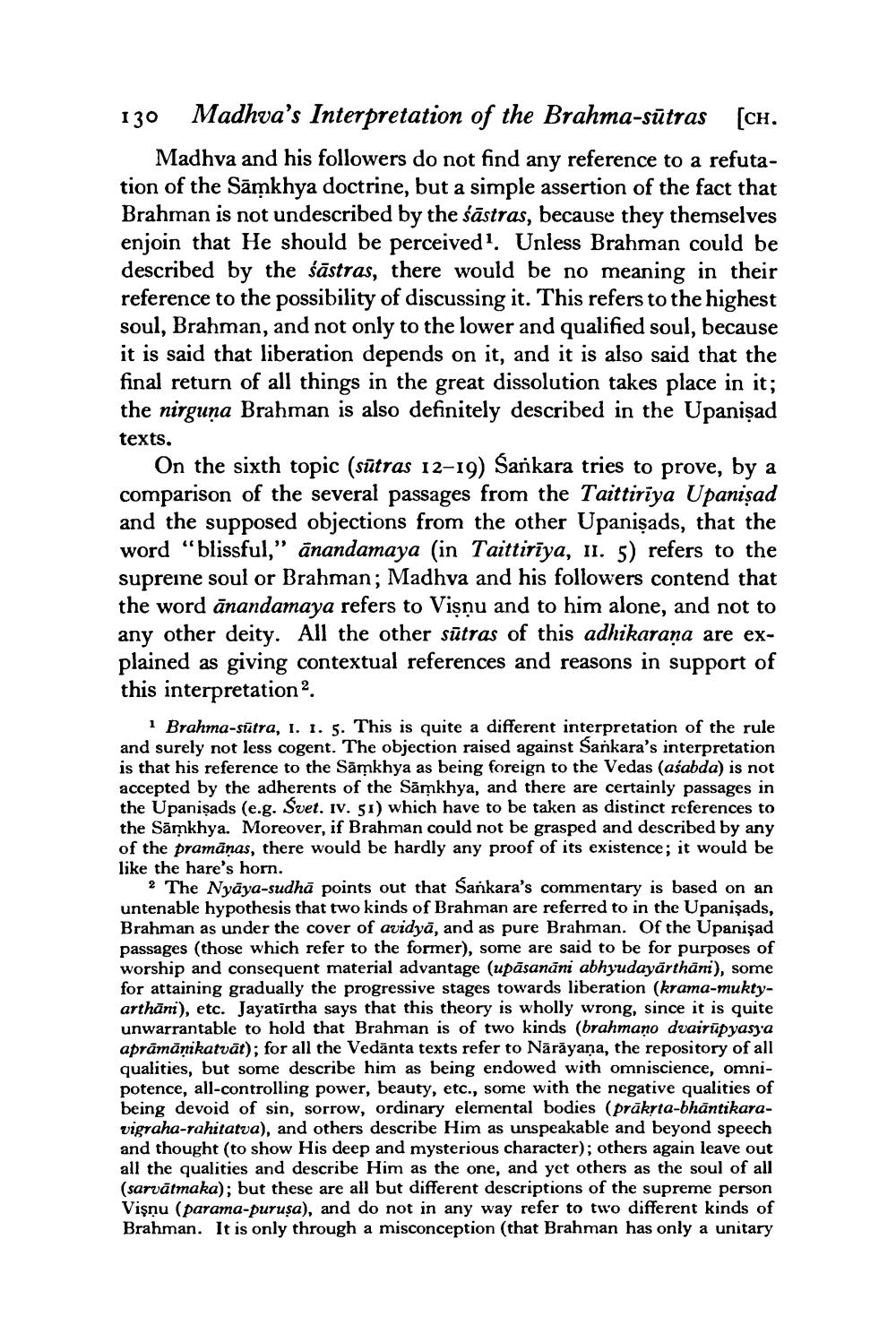________________
Madhva's Interpretation of the Brahma-sūtras [CH.
Madhva and his followers do not find any reference to a refutation of the Samkhya doctrine, but a simple assertion of the fact that Brahman is not undescribed by the sastras, because they themselves enjoin that He should be perceived1. Unless Brahman could be described by the sastras, there would be no meaning in their reference to the possibility of discussing it. This refers to the highest soul, Brahman, and not only to the lower and qualified soul, because it is said that liberation depends on it, and it is also said that the final return of all things in the great dissolution takes place in it; the nirguna Brahman is also definitely described in the Upanisad
texts.
130
On the sixth topic (sūtras 12-19) Sankara tries to prove, by a comparison of the several passages from the Taittiriya Upanisad and the supposed objections from the other Upanisads, that the word "blissful," ānandamaya (in Taittiriya, 11. 5) refers to the supreme soul or Brahman; Madhva and his followers contend that the word anandamaya refers to Visņu and to him alone, and not to any other deity. All the other sutras of this adhikarana are explained as giving contextual references and reasons in support of this interpretation2.
1 Brahma-sūtra, I. 1. 5. This is quite a different interpretation of the rule and surely not less cogent. The objection raised against Sankara's interpretation is that his reference to the Samkhya as being foreign to the Vedas (asabda) is not accepted by the adherents of the Samkhya, and there are certainly passages in the Upanisads (e.g. Svet. IV. 51) which have to be taken as distinct references to the Samkhya. Moreover, if Brahman could not be grasped and described by any of the pramāṇas, there would be hardly any proof of its existence; it would be like the hare's horn.
2 The Nyaya-sudha points out that Sankara's commentary is based on an untenable hypothesis that two kinds of Brahman are referred to in the Upanisads, Brahman as under the cover of avidya, and as pure Brahman. Of the Upanisad passages (those which refer to the former), some are said to be for purposes of worship and consequent material advantage (upāsanāni abhyudayārthāni), some for attaining gradually the progressive stages towards liberation (krama-muktyarthāni), etc. Jayatirtha says that this theory is wholly wrong, since it is quite unwarrantable to hold that Brahman is of two kinds (brahmaṇo dvairūpyasya aprāmāṇikatvāt); for all the Vedanta texts refer to Nārāyaṇa, the repository of all qualities, but some describe him as being endowed with omniscience, omnipotence, all-controlling power, beauty, etc., some with the negative qualities of being devoid of sin, sorrow, ordinary elemental bodies (prākṛta-bhāntikaravigraha-rahitatva), and others describe Him as unspeakable and beyond speech and thought (to show His deep and mysterious character); others again leave out all the qualities and describe Him as the one, and yet others as the soul of all (sarvātmaka); but these are all but different descriptions of the supreme person Vişņu (parama-puruşa), and do not in any way refer to two different kinds of Brahman. It is only through a misconception (that Brahman has only a unitary




